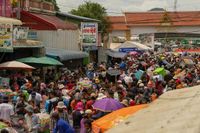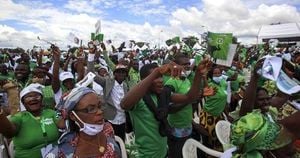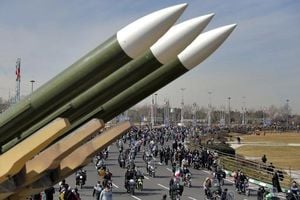On August 11, 2025, as dusk settled over the borderlands of Sa Kaeo province, Thai soldiers moved swiftly to intercept a group of Cambodians crossing illegally into Aranyaprathet district. The nine migrants—among them a 19-year-old man, a 21-year-old woman, and two minors aged 15 and 7—were desperate to escape joblessness in their homeland, a plight shared by thousands as the Thai-Cambodian border remains on edge following recent armed clashes.
The arrests, confirmed by the Royal Thai Army and reported by the Bangkok Post, unfolded in two separate incidents that evening. The first group, detained at 5 p.m., had arranged to meet a Thai smuggler, Thongchai Maenpuen, who admitted to being hired by a relative for a fee of 300 baht per person. The migrants, in turn, had scraped together a total of 13,000 baht to cover the costs of their perilous journey. The second group, apprehended at 10 p.m. after slipping through a natural crossing in Ban Phu Nam Liang village, included a couple aged 42 and 46, their children aged 13 and 8, and a 22-year-old man who joined them by chance. All shared a common story: they had once found work in Aranyaprathet’s bustling markets but, after returning home earlier in the summer, were unable to secure employment in Cambodia. With no income and little hope, they risked everything to return to Thailand and seek work from former employers.
These stories, while deeply personal, are emblematic of a much larger and more troubling exodus. According to Business Standard, hundreds of thousands of Cambodian migrant workers have been streaming home from Thailand since July, as the two countries struggle to maintain a fragile ceasefire. The spark for this mass movement was a five-day armed clash along their 800-kilometer border in July, which left at least 43 people dead and displaced more than 260,000 across both nations. The violence, rooted in long-standing disputes over pockets of land, sent shockwaves through communities on both sides, prompting a mass retreat of Cambodian laborers who had formed the backbone of Thailand’s farming, construction, and manufacturing sectors.
The ceasefire, brokered by Malaysia and backed by both the United States and China, has so far held, but uncertainty remains thick in the air. Cambodian Prime Minister Hun Manet took to Facebook to urge his countrymen to return home, a call that resonated with workers like 56-year-old poultry laborer Kri Phart. “I have no idea if the fighting will really stop and with fewer and fewer Cambodians in Thailand, I got nervous,” Kri Phart told Business Standard. “I didn’t want to be the last Cambodian migrant in Thailand.”
For many, the decision to leave Thailand was not taken lightly. Rumors swirled—some unfounded, others rooted in real fears—about attacks by gangs of young Thais, and even whispers that the Cambodian government might seize land or revoke citizenship from those who failed to return by mid-August. “Many of the Cambodians I knew working in Thailand ran away. Everyday more and more of us fled,” Kri Phart recounted, describing the chaotic scenes at the Daung International Border Gate, where migrants hauled their possessions in the sweltering 40-degree heat.
Back in Cambodia, the reality awaiting returnees has been sobering. The Ministry of Labour and Vocational Training estimates that, before the border conflict escalated in June, around 1.2 million Cambodians were working in Thailand. By August, about 780,000—roughly 65%—had returned. Ministry spokesman Sun Mesa insisted that workers could find jobs with equal pay and benefits at home, but many migrants remain deeply skeptical.
Thouk Houy, a 26-year-old who had worked at a leather factory south of Bangkok, shared her anxieties with Business Standard: “Now that I am back, there is going to be no income for a while and this will really put my family in a bad situation. I’m the last of my siblings who is still single, meaning it’s my responsibility to support my parents. I don’t know how I can do that now that I am back home.” For Thouk, minor disputes at the factory and her mother’s nightly pleas to return home were compounded by alarming claims from influential former Prime Minister Hun Sen that Thailand was preparing to invade. “Now that I’m home, what will I do to make a living?” she asked, echoing the uncertainty felt by thousands.
The economic stakes are enormous. Migrant workers like Thouk sent home an estimated $3 billion annually in remittances, according to Cambodia’s labor ministry. The sudden loss of this income is already threatening the financial stability of families across the country, many of whom rely on remittances to service large debts. Nathan Green, an assistant professor of geography at the National University of Singapore, told Business Standard, “These kinds of conflicts demonstrate how precarious migrant livelihoods are in Cambodia.”
Advocacy groups are sounding the alarm. The Khmer Movement for Democracy, an overseas organization, has called on the Cambodian government to defer loan payments and offer incentives to companies willing to hire returning migrants. “Without economic safeguards, families of returning migrants will not be able to repay their debts and financial institutions will be at their throats,” warned Mu Sochua, the group’s president. “We are talking about the poorest of the poor, who will be deprived of incomes.”
For some, the return to Cambodia is bittersweet. Meng Yeam, a 32-year-old former manager at a rubber factory in Chonburi Province, managed to send home 20,000 baht (about $600) while working in Thailand. Now, with more than 90% of his Cambodian colleagues gone, he faces an uncertain future. “Cambodia and Thailand need each other to do well, but for now, it seems like we just cannot get along,” Meng Yeam reflected. “I hope we can work in Thailand again one day, but who knows, maybe I will be retired by the time we stop fighting.”
The situation remains precarious. While the ceasefire has brought a measure of calm, the underlying tensions and economic hardships persist. For Cambodian families, the border is more than just a line on a map—it’s a lifeline to survival, one that has frayed under the weight of conflict and uncertainty. As both governments and international mediators work to broker a lasting peace, the fate of hundreds of thousands hangs in the balance, waiting for a resolution that will allow them to rebuild their lives with dignity and hope.





